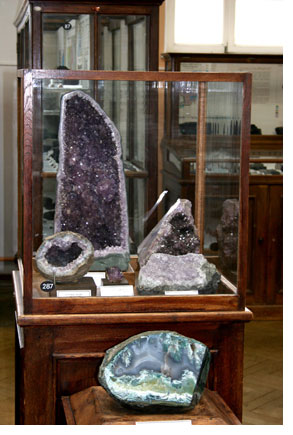 Purple quartz, called amethyst, has been known since ancient times. The name arose from the Greek “αμέθυστος”, abstainer. It was believed that this stone protects against drunkenness, since its colour resembles diluted wine, which the Greeks preferred to drink.
Purple quartz, called amethyst, has been known since ancient times. The name arose from the Greek “αμέθυστος”, abstainer. It was believed that this stone protects against drunkenness, since its colour resembles diluted wine, which the Greeks preferred to drink.
Amethyst, like rock crystal, is found in the form of beautiful crystals shaped as hexagonal prisms with a rhombohedral top. Amethyst crystals are often arranged in groups, intergrowths, called druses. The size of the crystals, as a rule, does not exceed 15 cm, occasionally reaching 45 cm. Large crystals are usually cloudy. In the crystal growth, zones of amethyst colour often alternate with smoky and colourless ones. The colour of amethyst is due to the structural admixture of ferric iron. Its shades in the crystals from different deposits are markedly different.
Amethyst is formed in pegmatites, metasomatites, ore and alpine veins at the final stage of crystal formation. Along with individual amethyst crystals, there are veins composed of a columnar aggregate of amethyst quartz. In effusive rocks, it fills amygdales, sometimes reaching a gigantic size. In the trap covers of Uruguay and Brazil, there are very large geodes up to 10x2 m in size, the walls of which are encrusted with amethyst crystals.